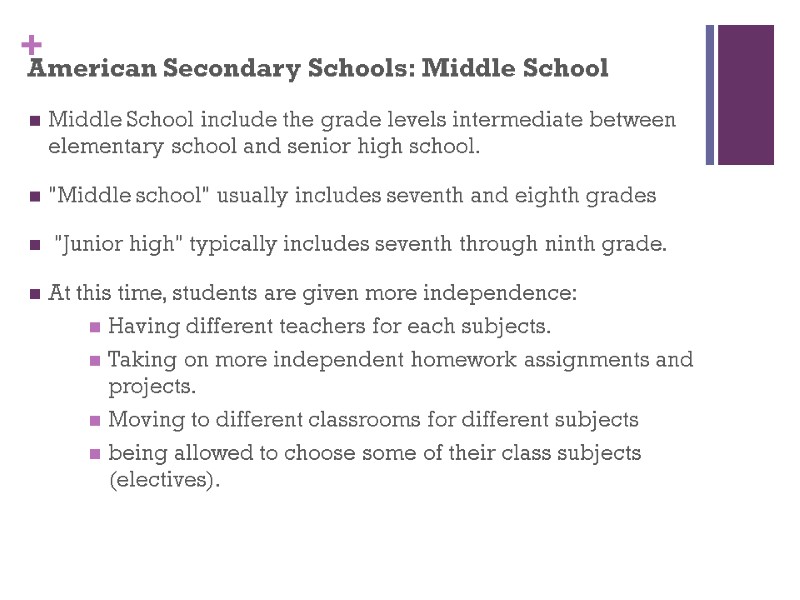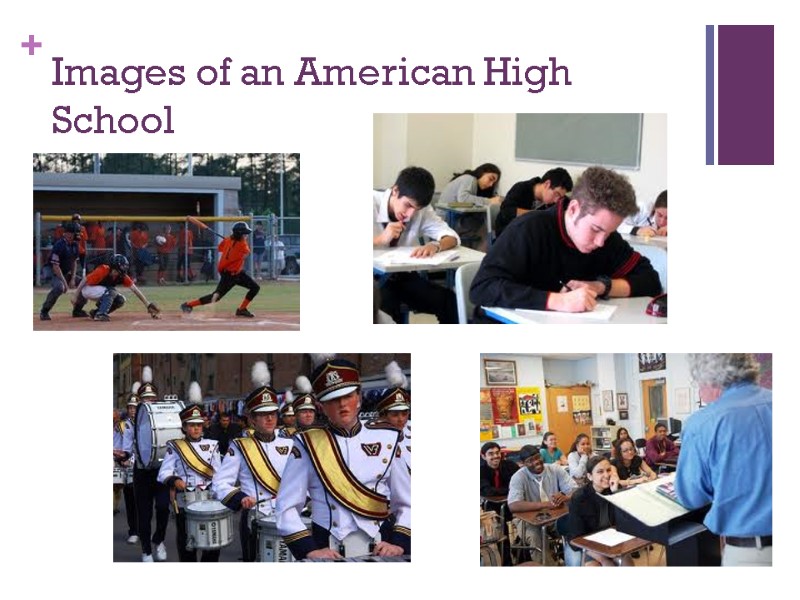The American Education System 21 December 2011 Danielle


The American Education System 21 December 2011 Danielle Montagne: English Language Fellow

Objective: During today’s lecture, we will discuss: The American Public School System (K-12) [A Brief] History of Education in America The goals/learning objectives of Public Schools in America Traditional Structure/Variations in Public School Structures American Public Elementary, Middle and High School Teacher/Student Case Studies Alternative Education Options (K-12) Contemporary Social Issues in k-12 Education Follow up Discussion Questions & Student Questions

Warm Up Questions… The American Public School System What do you know about the American Education system? Are there any stereotypes about American education or American students that you know of? How/where have you learned information about the American School system? How do you think American school system differs from the Belorussian School system? How do you think the American School system is similar to the Belorussia School system?

The American Public School System (K-12) History of the American Public School System The first American schools in the thirteen original colonies opened in the 17th century. Established for wealthy families who could afford to send their children to school. One room school houses would often serve primary, middle and high school age students. For most families, literacy and mathematics education was done in the homes—often by mothers –during America’s early history. Education for women, African Americans and non-English speaking immigrants was limited or outlawed until the 20th century.

History of the American Public School System After the American Revolution, an emphasis was put on education: Especially true in the northern states, which rapidly established public schools. By the year 1870, all states had free public elementary schools. Private academies flourished in the towns across the country, but rural areas (where most people lived) had few schools before the 1880s. By 1900, the US population had one of the highest literacy in the world. Education seen as necessary for developing intelligent American citizens capable in participating in all social and political realms of life.

Early American Schools…

Modern goals of the American Public School System Education is often seen as a means to deliver equality to all American citizens. K-12 Education is compulsory for all American children. Education is mainly provided by the public sector and funded by the federal, state and local governments. School curricula, funding, teaching, employment, and other policies are set through locally elected school boards who have control over a specified school district. The modern goals of the American education system is to develop: A well-rounded individual prepared with critical thinking skills problem solving skills creativity when approaching real life situations.

Traditional Structure of the American School System (K-12) The American School system traditionally consists of: Pre-school (age 3-5) –not compulsory Primary School/Elementary School Kindergarten (age 5-6) Grades 1-6 (ages 6-12) Middle School Grades 7-8 (ages 12-14) High School Grades 9-12 (ages 14-18)

K-12 Structures

American Primary/Elementary Schools Public Elementary School teachers instruct between 20-30 students of diverse learning needs. A typical classroom will include children with a range of learning needs or abilities, from those identified as having special needs (special education) to students non-native English speakers (ESL students). Each local school district gives each teacher a book to give to the students for each subject, and brief overviews of what the teacher are expected to teach. Learning standards are identified for all areas of a curriculum by individual States, including those for mathematics, social studies, science, physical development, the fine arts, and reading. Elementary School teachers are trained with emphases on human cognitive and psychological development and the principles of curriculum development and instruction. Teachers typically earn either a Bachelors or Masters Degree in Early Childhood and Elementary Education. Certification standards for teachers are determined by individual states.

Images of an American Elementary School…


Case Study: Typical Day of American Primary School Teacher A typical teacher works 8 hours, 5 days a week, at the same school. [September-June] Federal Holidays and Summer Vacations off from work. Primary school teachers traditionally teach the same group of students (20-30 students) for the full day. Courses include: Reading, Writing, Mathematics, Science, Social Studies. Teachers often have one (40-45 minute) break or “preparation period” during the day. Students receive classes from a different teacher—Music, Art, Gym (sports), Drama, Chorus, etc. Teachers must have one lunch break (40-45 minute) during the day. Many teachers stay after school to participate in extracurricular activities for students or provide additional teaching time.

Case Study: Typical Day of American Primary School Student School begins in early September through the end of June. Most students arrive to school by a big yellow school bus. Students generally attend all classes in the same classroom with the same group of [diverse] students. Students are taught strategies of working independently, in groups and in partners during the school day. Students usually have “recess” during the school day and often spend time on a playground with their friends. Being sent to the “principals office” is seen as a major punishment. Elementary school students are sent home with 30 minutes to 1 ½ hours of homework each night (depending on grade level). Extracurricular activities are popular for older elementary school students.

American Secondary Schools: Middle School Middle School include the grade levels intermediate between elementary school and senior high school. "Middle school" usually includes seventh and eighth grades "Junior high" typically includes seventh through ninth grade. At this time, students are given more independence: Having different teachers for each subjects. Taking on more independent homework assignments and projects. Moving to different classrooms for different subjects being allowed to choose some of their class subjects (electives).

Images of an American Middle School…


American Secondary Schools: Senior High School Senior High School is a school attended after middle school/ junior high school. The term “High school” is often used instead of senior high school High school usually runs either from 9th through 12th grade. The students in these grades are commonly referred to as: freshmen (grade 9) sophomores (grade 10) juniors (grade 11) seniors (grade 12). students take a broad variety of classes without special emphasis in any particular subject

Images of an American High School


High School Curriculum Students take a broad variety of classes without special emphasis in any particular subject. Curricula vary widely in quality and rigidity Some states consider 65 (on a 100-point scale) a passing grade, while others consider it to be as low as 60 or as high as 75. Mandatory subjects are required in nearly all U.S. high schools: Science (3 years of biology, chemistry and physics) Mathematics (4 years of algebra, geometry, pre-calculus, statistics, and calculus) English (4 years of literature, humanities, composition, etc.) Social sciences (3 years world and U.S. history, gov./economics) Physical education (4 years) Many states require a "health" course (anatomy, first aid, sexuality, birth control)

Students Choice: Elective Classes Computers: Word processing, programming, graphic design… Career and Technical Training: Business Marketing, health occupations, technology education, publishing, journalism, public speaking, creative writing, poetry… Performing Arts/Visual Arts: Choir, band, orchestra, drama, art, ceramics, photography, dance… Foreign Languages: Spanish/French most common… Advanced Placement Courses (AP): College Credit Courses Sciences, History, Economics, Art, Etc…

Extracurricular Activities in American Schools A major characteristic of American schools is the high priority given to sports, clubs and activities by the community, the parents, the schools and the students themselves. Extracurricular activities are educational activities not falling within the scope of the regular curriculum but under the supervision of the school. These activities can extend to large amounts of time outside the normal school day and include: Sports Programs—Football, Basketball, Soccer, Swimming, Wrestling, Cheerleading, Rowing, Dance, etc. Performing Arts—orchestra bands, jazz bands, marching bands, choirs, school plays/drama clubs/musicals Debate teams, Student Government, Public Awareness Organizations, Various Clubs (Poetry Club, Photography Club, etc.)


Social Life and School Related Activities A major characteristic of American schools is the rich social events that are planned and organized by the high schools. Formal Dances Yearly Semiformal Dances Junior Prom Senior Prom/Senior Ball Homecoming Day and Parade Organized Parade Homecoming King and Queen elected by students Celebration at the school Sports Activities and related social events Football games Bonfires and Rallys Graduation Celebrations


Case Study: Typical Day of American High School Teacher A typical teacher works 8 hours, 5 days a week, at the same school. [September-June] Federal Holidays and Summer Vacations off from work. High school teachers teach the same subject to: 6 groups of students (45-50 minute classes) each day OR 3 groups of students (90 minutes) every other day Teaching specialty depends on teaching degree Teachers often have one “preparation period” (45 minutes) during the day. Teachers must have one lunch break (40-45 minute) during the day. Many teachers stay after school to participate in extracurricular activities for students or provide additional teaching time.

Case Study: Typical Day of American High School Student School begins in early September through the end of June Some student arrive to school by school bus; many others drive. Students attend 4-8 classes each school day. Students must remain at school for the entire day—leaving for lunch is not allowed. Students are taught strategies of working independently, in groups and in partners during the school day. Students usually have “study hall” during the school day and to prepare for classes, study for exams or meet with teachers. High school students are sent home with 2 to 3 hours of homework each night (depending on grade/skill level). Many students stay after school to participate in sports, clubs and other extracurricular activities.

Alternative forms of Education Home schooling In 2007, approximately 1.5 million children were home ] schooled: 2.9% of all children. Often associated with religious groups. Private Schools/Private Academies Funded solely by student tuition. Offer more specialized courses. Parochial School Run by church organizations. Funded by student tuition and petitioner contributions. Charter School Funded by both private funds and public funds. Stricter control over enrollment—controversial.

Modern Social Issues in American Education Educational issues in the United States center on curriculum, funding, and control. Funding U.S. is tied for first place with Switzerland for annual spending per student: two countries spending more than $11,000 USD U.S. public schools lag behind the schools of other developed countries in the areas of reading, math, and science. No Child Left Behind Act– George W. Bush : Gives government the right to withhold funding if it believes a school, district, or even a state is improving standardized test scores. Tracking Dividing students into learning groups based on classifications of “above average”, “average” or “below average” Separating ESL students and Special Education students from mainstream classrooms.

Modern Social Issues in American Education English in the Classroom Questions on how to best accommodate for non-English speaking students and parent interest in foreign language instruction. ESL programs vs. Bilingual programs Dual Language Programs Nationwide Education Content and Education Quality Different content, grade systems and quality across the nation Textbook Review and Adoption Evolution in Kansas Violence and Drug Use Preventing violence and drug abuse in schools Education regarding violence, sex and drug abuse

Questions or Comments? Please ask me any questions about today’s lecture topic, my personal background or any other question you might have. Contact Information Danielle Marie Montagne Email: [email protected] Please feel free to contact me anytime with any questions, assistance or guidance you need in any class.
9942-american_education_system.ppt
- Количество слайдов: 32

